.357 Magnum vs 9mm: Choosing Between a Revolver and Semi-Auto
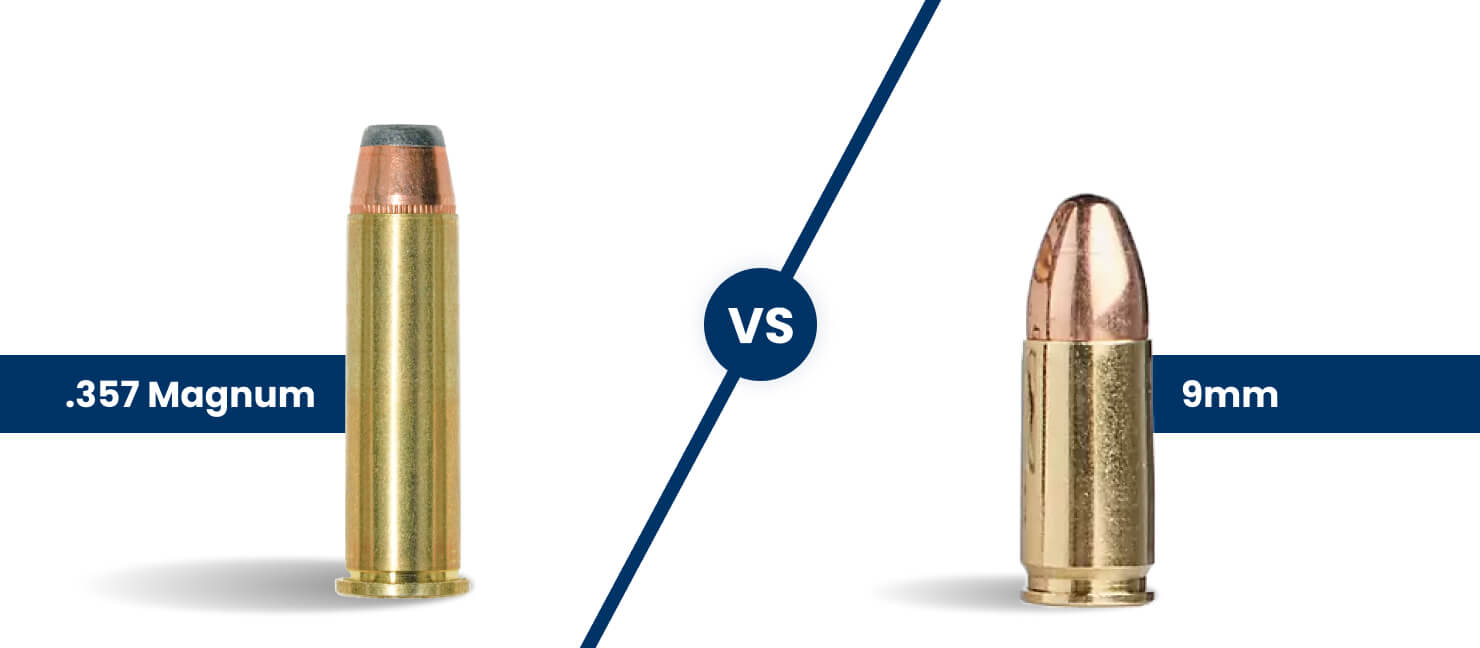
Is a .357 Magnum superior to a 9mm? The ongoing debate between the .357 Magnum and the 9mm (also known as 9mm Luger) revolves around their effectiveness in various scenarios, from self-defense to hunting and range shooting.
If you're in the market for a cartridge that suits your needs, it's essential to understand the key differences between these two options. In this article, we'll delve into the bullet specs and highlight the differences between the .357 Magnum and 9mm.
Key Takeaways
- 357 Magnum vs 9mm: Ballistics Overview: The .357 Magnum and the 9mm Luger have similar bullet diameters. However, the .357 Magnum has a higher bullet weight, case capacity, and max pressure.
- What’s the Main Difference Between the .357 Magnum and the 9mm? The .357 Magnum is a popular cartridge for revolvers, offering high muzzle velocity and a flat trajectory. Semi-automatic pistols feature 9mm, which is helpful for self-defense and has a higher ammo capacity.
- Popular Firearms in Each Caliber: The SIG SAUER P320-M18 9mm Pistol and the Canik TP9SF All Tungsten 9mm Pistol are popular 9mm options, while the Ruger® Vaquero .357 Revolver and the Colt Python 357 Magnum 4.25 in Revolver are popular .357 Magnum options.
- .357 Magnum vs 9mm: Hunting, Self-Defense & Home Defense: The 9mm is reliable for self-defense and concealed carry, while the .357 Magnum excels in hunting. Both cartridges can be useful for home defense scenarios.
.357 Magnum vs 9mm: Ballistics Overview
The .357 Magnum, developed by Smith & Wesson in the 1930s, has a historical connection with law enforcement. It’s now widely embraced by civilians. The 9mm originated in 1901 and played a major role in WWI and WWII. During the 1980s, the 9mm experienced a resurgence in popularity, becoming a favored choice among civilian shooters and law enforcement agencies alike.
The 9mm Luger is a popular choice for semi-automatic pistols, while gun experts popularized the .357 Magnum cartridge with revolvers. You can also find the .357 Magnum in other firearms like lever-action rifles and carbines. Conversely, you can find the 9mm in options like certain revolvers. The 9mm is the most popular caliber for the semi-automatic pistol, while the .357 Magnum is the most popular cartridge for the revolver.
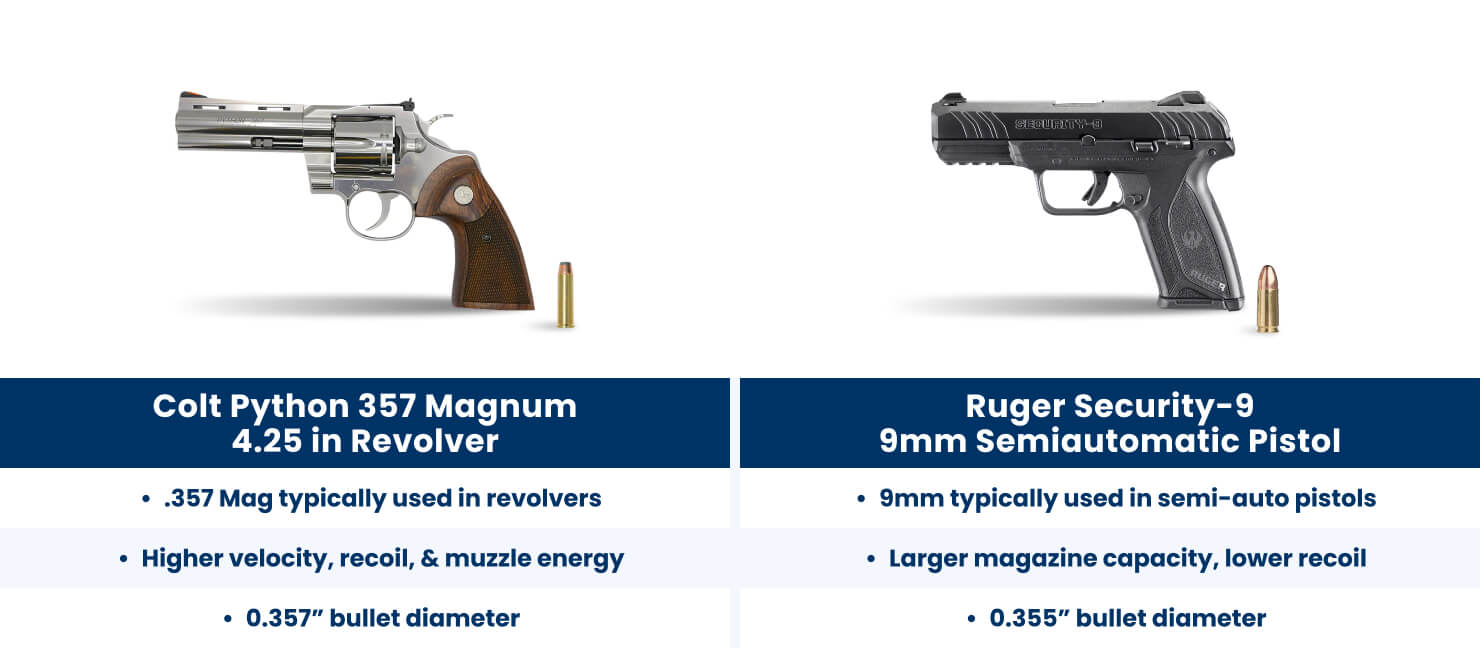
Handguns for the 9mm are valued for their larger magazine capacity and reduced recoil, making them a popular choice. On the other hand, gun experts celebrate the .357 Magnum for its higher velocity, recoil, and muzzle energy. Although both cartridges share a similar bullet diameter (0.357 inches for the .357 Magnum vs. 0.355 inches for the 9mm), they significantly differ in case length and capacity.
The .357 Magnum features a taller case and can accommodate bullets weighing up to 180 grains, whereas the 9mm Luger is limited to bullets weighing up to 147 grains. Continue reading for a detailed comparison, including maximum length, pressure, and more.
| .357 Magnum vs 9mm: Bullet Specs | ||
|---|---|---|
| Category | 9mm | .357 Magnum |
| Popular Firearm | Semi-automatic pistol | Revolver |
| Case Length | 9.15 mm | 33 mm |
| Max Length | 26.69 mm | 40 mm |
| Bullet Weight | 115-147 grains | 125-180 grains |
| Bullet Diameter | .355 in. (9.01 mm) | .357 in. (9.1 mm) |
| Case Capacity | 13.3 grains H20 | 26.2 grains H20 |
| Max Pressure | 34,084 PSI | 35,000 PSI |
Case Length: The measurement of the cartridge case, not including the bullet. This does not include the tip of the bullet.
Max Length: The measurement from the top of the bullet to the bottom of its casing. This includes the loaded cartridge's total length.
Bullet Diameter: The bullet diameter is the diameter of the bullet without its casing.
Case Capacity: The volume inside the cartridge case that can hold liquid. This is typically measured when the bullet is not yet inserted.
Max Pressure (SAAMI): SAAMI stands for Sporting Arms and Ammunition Manufacturers' Institute, which sets industry standards for ammunition. Max Pressure (SAAMI) represents the maximum safe pressure levels for ammunition.
The 9mm Luger has a shorter case length compared to the .357 Magnum (9.15 mm vs 33 mm). It also features a shorter max length (26.69 mm vs 40 mm). The case length and overall length impact velocity. Longer bullets can withstand wind drift more so compared to shorter cartridges. See these comparisons below.
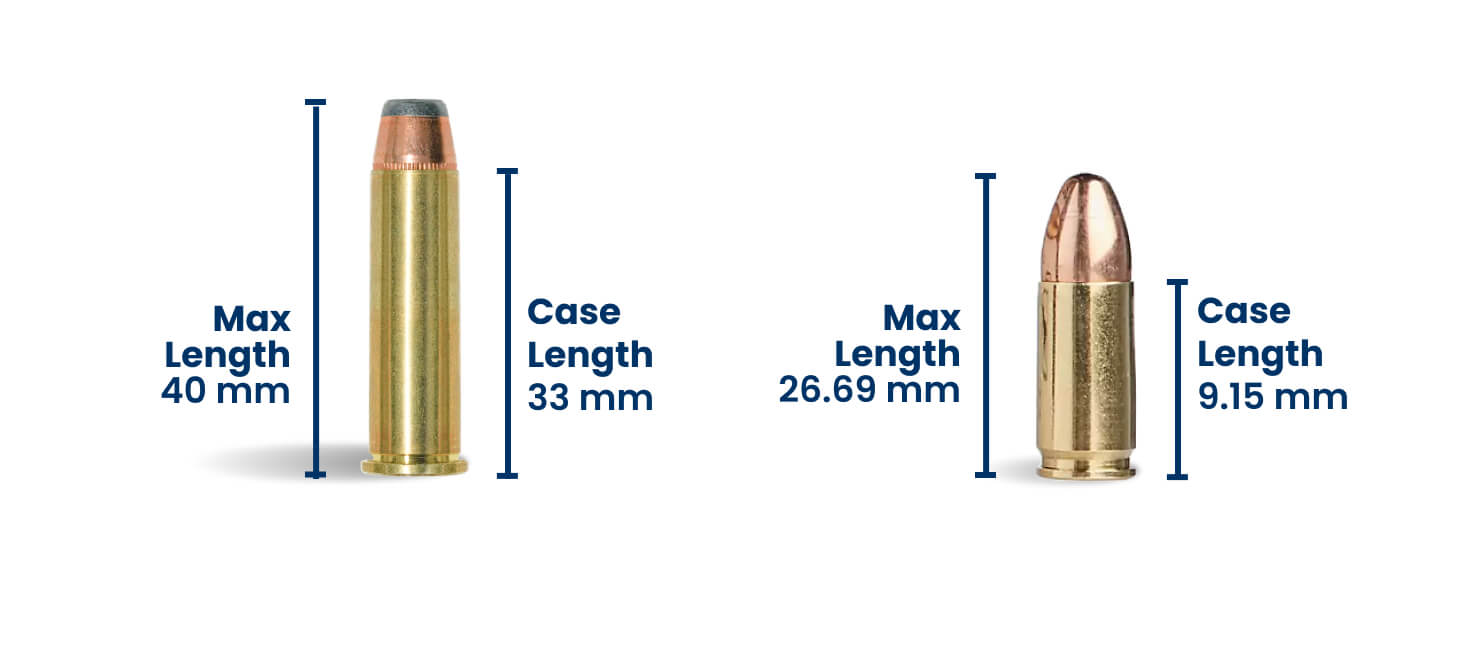
What’s the Main Difference Between the .357 Magnum and the 9mm?
The primary distinction between the .357 vs 9mm Luger lies in the types of firearms they are primarily associated with. The .357 Magnum is primarily used in revolvers, while the 9mm Luger finds its home in semi-automatic pistols. Other distinct characteristics and applications that set them apart include the following:
Bullet Diameter: The .357 Magnum utilizes a .357-inch bullet diameter and is known for its stopping power. The 9mm Luger employs a slightly smaller .355-inch bullet, balancing recoil control and effectiveness.
9mm Adaptations: The 9mm Luger offers versatility through its multiple variants like 9x21, 9mm Short (also known as .380 ACP), and the 9mm Browning, among others. The 9x19 is one of the most popular variations of the 9mm. It also goes by the 9mm NATO, 9mm Parabellum, and simply the 9mm.
.357 Magnum Variations: The .357 has also seen adaptations. Notably, the .357 SIG combines the best of both worlds (it’s a cross between the .357 Magnum and 9mm). Other variations like the .357 Remington Maximum and the .357 SuperMag cater to specific shooting needs and preferences.
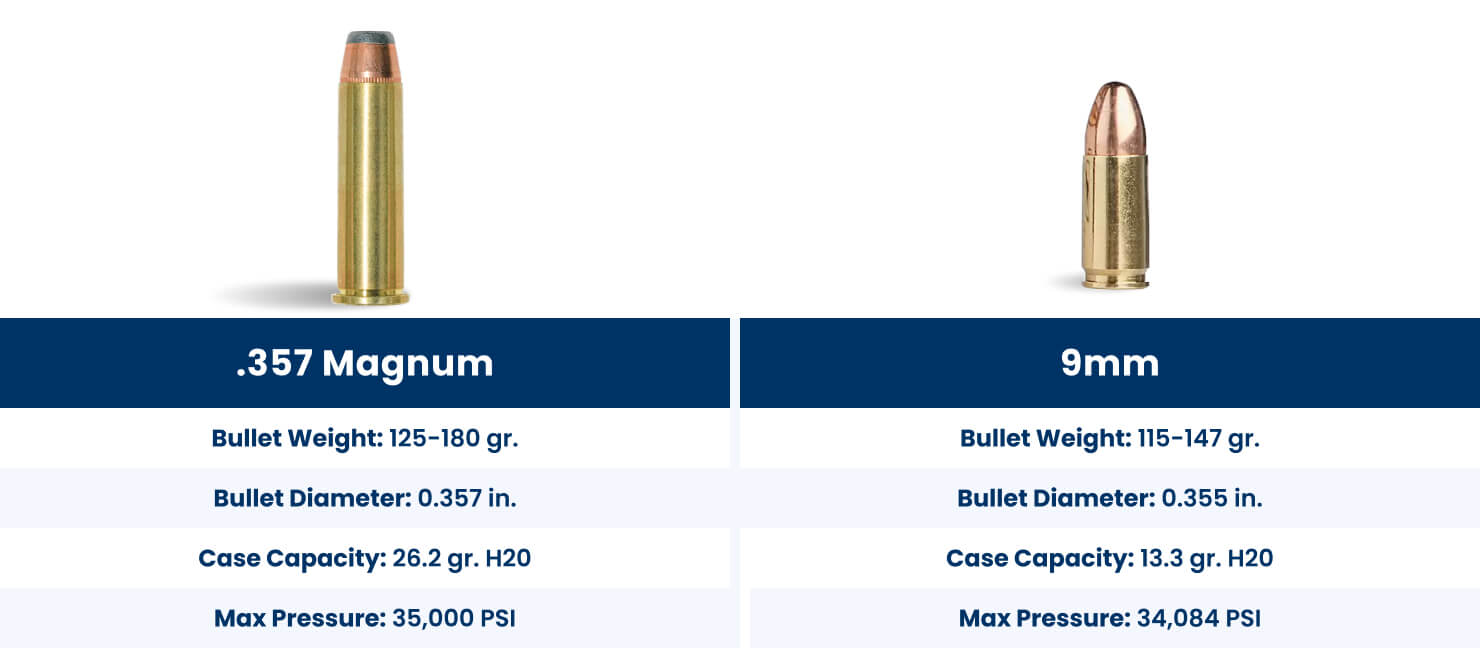
To delve deeper into the debate between the .357 vs 9mm, we decided to look at how they compare when it comes to price, recoil, velocity, and more. Keep reading to see which category each cartridge excels in.
| .357 vs 9mm: Key Differences | ||
|---|---|---|
| Category | .357 Magnum | 9mm |
| Applications | Hunting, target | Self-defense, home defense, target |
| Price | More expensive: $0.60-$2.20 per round | Less expensive: $0.30-$1.00 per round |
| Recoil | Strong recoil, especially in lightweight handguns | Moderate recoil, manageable for most shooters |
| Muzzle Energy | High energy, excellent stopping power for large wildlife | Moderate energy, sufficient for self-defense |
| Velocity | Fast velocity, longer range | Typically higher in semi-auto handguns |
| Trajectory | Generally flat trajectory, suitable for longer ranges | Generally flat trajectory with minimal drop at longer ranges |
| Load Capacity | Varies by firearm type, often lower in revolvers | Typically higher in semi-auto handguns |
Applications
Both the .357 Magnum and the 9mm Luger have a history in law enforcement. See how the .357 Magnum and the 9mm Luger compare when it comes to preferred uses.
- The .357 Magnum has been a top choice for hunting medium-sized game. The .357 Magnum is also popular among target shooters.
- Gun experts choose the 9mm for concealed carry and self-defense in semi-automatic handguns. It’s also preferred for target shooting thanks to its user-friendly recoil.
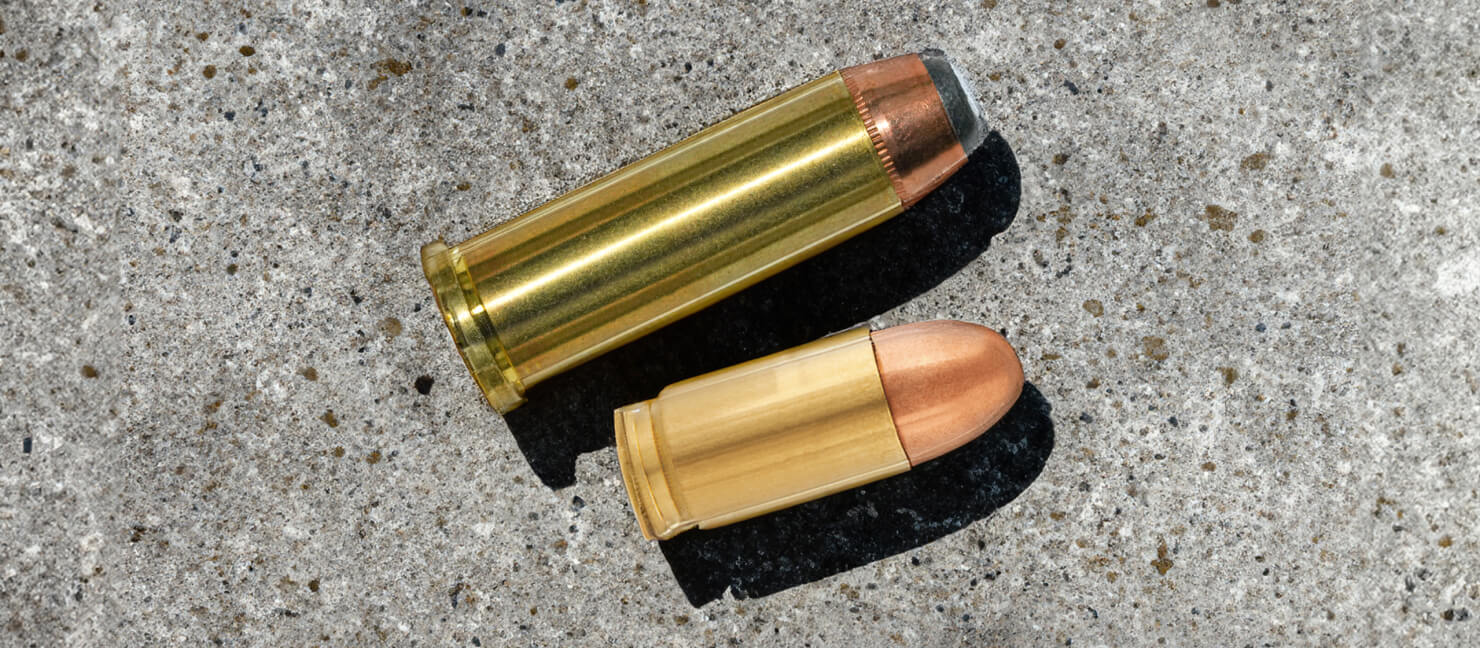
Price
When it comes to cost, the 9mm Luger often comes out as the more budget-friendly option compared to the .357 Magnum. Let's dive into the specifics of their pricing.
-
Ammo for the .357 Magnum tends to be pricier per round. The cost can vary depending on factors like the manufacturer and the specific type of ammunition you choose.
-
The 9mm is generally known for its affordability compared to the .357 Magnum. This is partly due to its widespread availability, which contributes to lower prices across various brands.
Recoil
The .357 Magnum is known for its stronger recoil than the 9mm. The 9mm offers a more manageable shooting experience for faster follow-up shots.
-
The .357 Magnum is renowned for its robust recoil. You can feel this even more in lightweight revolvers. This recoil can be challenging for some shooters to manage effectively.
-
The 9mm offers moderate recoil, making it easier for most shooters to control. This advantage holds true even in compact handguns.
Muzzle Energy
Muzzle energy is a critical aspect of bullet performance, representing the kinetic energy the bullet carries as it exits the gun's barrel and muzzle. The .357 Magnum stands out for its higher muzzle energy compared to the 9mm.
-
The .357 Magnum is known for its impressive muzzle energy. It generates roughly 600 ft-lbs of energy at the muzzle, making it well-suited for scenarios like hunting large game or predators.
-
The 9mm offers a moderate level of muzzle energy, around 340 ft-lbs. While not as powerful as the .357 Magnum, it still provides sufficient energy for self-defense purposes.
Velocity
Velocity is important in determining a bullet's performance. In comparing the .357 Magnum and the 9mm Luger, the .357 Magnum stands out for its higher velocity.
-
The 125-grain jacketed hollow point .357 Magnum achieves impressive velocities — reaching speeds of 1,450 feet per second (fps). This higher velocity contributes to greater range and less bullet drop.
-
The 124-grain 9mm round generates velocities of around 1,150 fps. While it may not match the .357 Magnum in speed, the 9mm performs well within typical self-defense distances.
Trajectory
Trajectory refers to the path a bullet follows after it leaves the gun’s barrel. The .357 Magnum benefits from its velocity, resulting in a flatter trajectory. The 9mm Luger lacks the same trajectory advantage.
-
The .357 Magnum has a generally flat trajectory, with minimal bullet drop at longer ranges. This flat trajectory enhances range and makes it well-suited for hunting.
-
The 9mm also features a flat trajectory, which is helpful for personal defense. However, it doesn't match the .357 Magnum's trajectory, especially when shooting over longer distances.
Load Capacity
The 9mm Luger has a higher load capacity than the .357 Magnum. See how they compare below.
-
Load capacity in the .357 Magnum varies depending on the type of firearm. Revolvers usually hold fewer rounds, with most limited to roughly six rounds.
-
Semi-automatic handguns chambered in 9mm typically offer higher load capacities. Their magazine-fed design allows for the storage of more rounds, typically 15 rounds or more.
Popular Firearms in Each Caliber
When it comes to firearms chambered in these calibers, there's a wide range of options to choose from, including pistols, revolvers, and rifles. However, the 9mm semiautomatic pistol and the .357 Magnum revolver are two standout choices. Other popular options include:
-
The SIG SAUER P320-M18 9mm Pistol, Canik TP9SF All Tungsten 9mm Pistol, and the Smith and Wesson M&P9 Shield Plus TS 9mm Pistol are great home defense options.
-
The Smith & Wesson 686 Plus .357 Magnum Revolver, Ruger® Vaquero .357 Revolver, and the Colt Python 357 Magnum 4.25 in Revolver are reliable options for hunting or defense.
.357 Magnum
- Hunting: The .357 Magnum proves effective for hunting medium to large-sized game, depending on the grain.
- Variations Available: Other variations are available, including the 357 SIG and the .357 Remington Maximum.
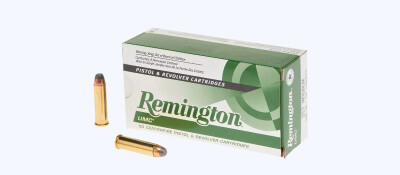
9mm
- Self-Defense: The 9mm is popular in law enforcement and self-defense thanks to its load capacity and reliability. Some options can house up to 17 rounds.
- Variations Available: Many rounds exist, including the 9mm NATO and 9mm Luger.
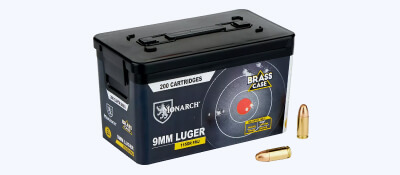
.357 Magnum vs 9mm: Hunting, Self-Defense & Home Defense
The .357 Magnum is a preferred choice for hunters, thanks to its impressive muzzle energy which can penetrate thick hides. Its higher velocity contributes to a flatter trajectory and longer range, making it ideal for camping or hunting where defense against large predators is necessary.
The 9mm is favored for self-defense, home defense, law-enforcement scenarios, and for less experienced shooters due to its limited stopping power, lower penetration, and milder recoil. The 9mm is not a good choice for hunting white-tailed deer and similar game because of its lower muzzle energy.
Have Fun Out There!
Ready to settle the debate between the semi-automatic pistol and the revolver? Explore a wide selection of .357 Magnum and 9mm ammo to put both cartridges to the test. If you're in the market for a hunting revolver, the .357 Magnum is your top choice. For self-defense purposes, opt for 9mm ammo. Make your selection wisely and find the perfect ammunition for your needs.


